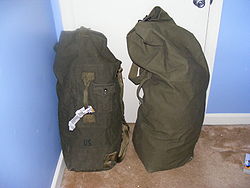Defensive

- Ballistic vests
- The Improved Modular Tactical Vest (IMTV) is the newest and most advanced vest in Marine inventories, with better protection and mobility than previous vests and a quick-release.
- The Improved Scalable Plate Carrier was developed for troops in Afghanistan because of concerns of excessive weight limiting mobility, especially in mountainous terrain. [1]
- The Personnel Armor System for Ground Troops (PASGT) vest remains in some limited use in training and non-deployable units.
- The Full Spectrum Battle Equipment kit includes a quick-release ballistic vest, integrated breathing and flotation devices, as well as load bearing equipment. [2]
- The Combat Integrated Releasable Armor System (CIRAS) has replaced the FSBE AAV for some units.
- The PRU-70 for aviators and aircrew combines body armor, survival vest, and flotation device.
- Combat helmets
- The Enhanced Combat Helmet (ECH) is a made of high-strength polyethylene with superior ballistic protection compared to previous Kevlar helmets. The ECH is being issued to all units. Previous helmets like the LWH are being retained for training and noncombat use.
- The Lightweight Helmet (LWH) can be used with the older sling suspension or a newer pad suspension to fit the helmet to the head, [3] as well as a nape protection system to add ballistic protection to the rear of the head. [4]
- The MICH TC-2000 Combat Helmet is issued to some specialized units.
- The Enhanced Combat Vehicle Crewman’s Helmet (ECVCH) allows the crew of AAV and LAV vehicles to communicate with less restriction on mobility and situational awareness without reducing ballistic protection. [5]
- Most pilots and aircrew wear a flight helmet for protection from aviation-related hazards (such as an integrated oxygen mask), but typically offers little ballistic protection.
- The Pith helmet is worn not for ballistic protection, but to identify weapons range coaches and other range personnel.
- The Integrated Helmet System (IHS) is a new hi-cut system being introduced to infantry units. The helmet was designed to support single-size components (NVG shroud, rails, harness, accessory straps) for ease of maintenance and supply logistics, with a clear upgrade and support path through its service life. [6] The system is typically used in tandem with a Hearing Enhancement Device produced by 3M. [7]

- Other armor
- Small Arms Protective Inserts (SAPI) are used with the MTV and OTV to provide protection beyond what the vest itself offers. SAPI are also available in side plates to protect the torso. [8]
- The OTV can be adapted with the Armor Protective Enhancement System (APES) that adds ballistic protection to the shoulder, armpit, and upper arm. [9]
- The Advanced Bomb Suit is used by Explosive Ordnance Disposal.
- The Sea Dragon 2025 is an experimental battledress being tested for the US Marine Corps as a replacement for the Marine Corps Combat Utility Uniform
- Chemical, biological, radiological, and nuclear defense
- The M50 joint service general purpose mask is the standard gas mask. [10] [11]
- Mission Oriented Protective Posture (MOPP) is a nuclear, biological, chemical suit with overalls, a hooded jacket, gloves, and overboots to protect against direct contact with contaminants. [12]
- The Mk I Nerve Agent Antidote Kit (NAAK) consists of a pair of autoinjectors containing atropine sulfate and pralidoxime chloride for first aid against nerve agents, and are due to be replaced by the single ATNAA.








